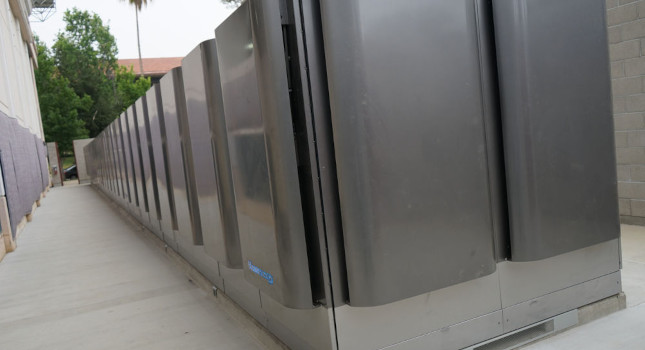Hydrogen blending demonstration with fuel cells
Companies, utilities and research institutions are investing resources into advancing hydrogen’s role in the net-zero economy. One such project involves a prestigious university in California.
Dozens of countries have committed to net-zero emissions goals in the coming decades. Hydrogen is required to reach these deep decarbonization goals. The Hydrogen Council projects that hydrogen could be 18% of global energy in 2050.
The hydrogen economy is advancing across numerous sectors including power generation, transportation, industrial energy, building heat and power, and feedstock.

The fuel cell server installed at the California Institute of Technology (Caltech) campus in Pasadena as part of a larger project with SoCalGas. Courtesy: Bloom Energy
Blending Hydrogen into the Natural Gas Network at Caltech
Bloom Energy’s Solid Oxide Fuel Cells (SOFC) have been deployed in 100s of applications across healthcare, data centers, critical manufacturing, retailers and more. The same proven fuel cell technology that has powered Bloom’s natural gas fleet is being used to generate combustion-free, emissions-free and carbon-free electricity from hydrogen. The technology enables highly efficient, distributed power generation.
Southern California Gas Co. (SoCalGas) is providing resilient, sustainable solutions to customers. A number of gas utilities have installed fuel cells to provide clean, reliable power to various facilities.
Additionally, SoCalGas is collaborating on an initiative to generate and then blend hydrogen into the existing natural gas network at the California Institute of Technology (Caltech).The project will first generate hydrogen and then blend it into the university’s existing natural gas network to demonstrate how natural gas infrastructure can be decarbonized, while balancing energy supply and demand. The project is set to launch in late 2022 on the Caltech campus in Pasadena.
A collaboration will utilize Bloom Energy’s solid oxide high-temperature electrolyzer to generate hydrogen, which will be injected into Caltech’s natural gas infrastructure. The resulting hydrogen blend will then be converted into electricity without combustion through fuel cells downstream of the SoCalGas meter, producing electricity for a portion of the university. Using grid power to make H2 from water to then put the H2 into a 40-60% efficient fuel cell to make electric does not really make sense. Its more to prove a concept for future green hydrogen.
At scale, the electrolyzer and fuel cell combination could enable long-duration clean energy storage and low-carbon distributed power generation through the gas network for businesses, residential neighborhoods, and dense urban areas. When configured as microgrids, fuel cells provide resilient power when and where energy is needed most, protecting businesses, campuses or neighborhoods from widespread power outages.
“We need to pursue a diverse set of decarbonization levers,” said Maryam Brown, president, SoCalGas in a press release. “Projects like this expand and accelerate clean fuel initiatives, which will help decarbonize California faster.”
High-temperature electrolyzers produces hydrogen more efficiently than low-temperature PEM and alkaline electrolyzers. Because it operates at high temperatures, the Electrolyzer requires less energy to break up water molecules and produce hydrogen. Electricity accounts for nearly 80% of the cost of hydrogen from electrolysis. By using less electricity, hydrogen production becomes more economical and will accelerate adoption. The Electrolyzer is also designed to produce green hydrogen from 100 percent renewable power.
SoCalGas is actively engaged in more than 10 pilot projects related to hydrogen and also is evaluating the potential to use existing infrastructure for transporting hydrogen through testing and demonstration at its engineering analysis center and is collaborating with California’s other gas utilities and research institutions to develop a hydrogen blending standard for regulatory review.
Demonstrations provide path to commercialization
This project is a good example of corporate and education institutions coming together to further energy initiatives. By demonstrating how hydrogen can be blended with natural gas, it gives the industry a proof point in the transition to net zero.
– This article appeared in the Gas Technology supplement.
URLS
Bloom Energy
SoCalGas
California Institute of Technology
Do you have experience and expertise with the topics mentioned in this content? You should consider contributing to our CFE Media editorial team and getting the recognition you and your company deserve. Click here to start this process.



